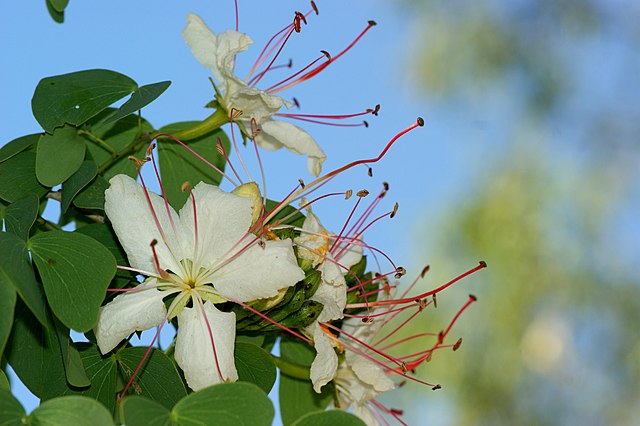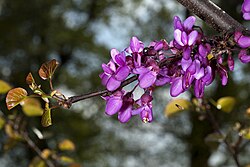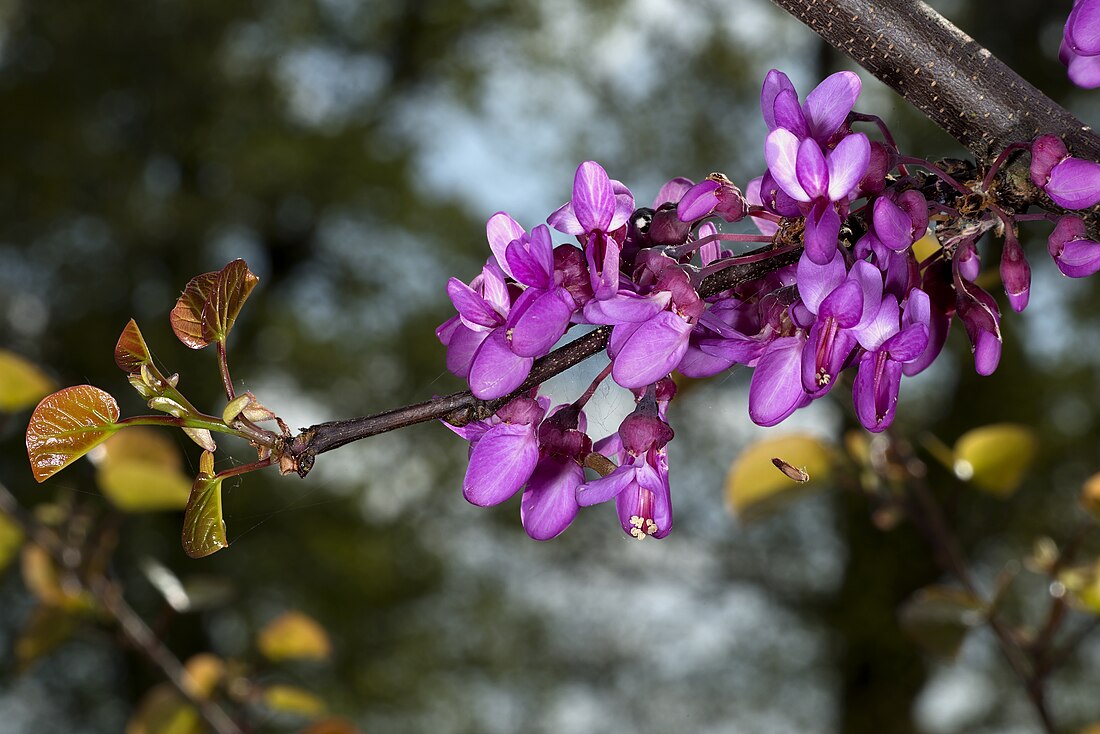Cercidoideae é uma subfamília de plantas com flor da família Fabaceae que inclui diversas espécies comuns, entre as quais Cercis siliquastrum (olaia).
| Cercidoideae | |||||||||||||||
|---|---|---|---|---|---|---|---|---|---|---|---|---|---|---|---|

Phanera variegata. | |||||||||||||||
| Classificação científica | |||||||||||||||
| |||||||||||||||
| Género-tipo | |||||||||||||||
| Cercis L. | |||||||||||||||
| Géneros | |||||||||||||||
| Ver texto. | |||||||||||||||
| Sinónimos | |||||||||||||||
| |||||||||||||||
Descrição
A subfamília Cercidoideae inclui, entre outros, os géneros Cercis (olaias), o qual agrupa diversas espécies amplamente cultivadas nas regiões temperadas, Bauhinia, cultivado como árvore ornamental nas regiões tropicais da Ásia, e Tylosema esculentum (marama), uma cultura alimentar tradicional da África.
A subfamília ocupa uma posição basal na filogenia das Fabaceae, constituindo um clado cuja monofilia é suportada por múltiplos estudos de filogenia molecular.[2][3][4][5][6][7] Em consequência, na 6.ª International Legume Conference, o Legume Phylogeny Working Group propôs a elevação da anterior tribo Cercideae da subfamília Caesalpinioideae ao nível taxonómico de subfamília no contexto das Leguminosae (Fabaceae).[8] O consenso foi no sentido da mudança, a qual foi implementada em 2017.[1]
A nova subfamília é definida como sendo «o clado coroa mais inclusivo que contenha Cercis canadensis L. e Bauhinia divaricata L. mas não Poeppigia procera C.Presl, Duparquetia orchidacea Baill., ou Bobgunnia fistuloides (Harms) J.H.Kirkbr. & Wiersema.»[1]
Muitos dos géneros desta subfamília apresentam pólen com características muito diferenciadas. Esta palinologia9 única é um dos elementos diferenciadores.[9][10]
Taxonomia


A posição sistemática do grupo com a presente circunscrição, determinada pelas técnicas da filogenia molecular, sugere a seguinte árvore evolucionária:[11][12][13][14][15][16][17]
| Polygalaceae | |||||||||||||||||||||||||||||||
| Surianaceae | |||||||||||||||||||||||||||||||
| Fabales | |||||||||||||||||||||||||||||||
| Quillajaceae | |||||||||||||||||||||||||||||||
| Cercidoideae | |||||||||||||||||||||||||||||||
| Detarioideae | |||||||||||||||||||||||||||||||
| Fabaceae | |||||||||||||||||||||||||||||||
| Duparquetioideae | |||||||||||||||||||||||||||||||
| Dialioideae | |||||||||||||||||||||||||||||||
| Caesalpinioideae | |||||||||||||||||||||||||||||||
| Faboideae | |||||||||||||||||||||||||||||||
A subfamília Cercidoideae integra os seguintes géneros[1][18][19] organizados em subtribos:[20]
Cercideae
- Adenolobus (Harv. ex Benth. & Hook.f.) Torre & Hillc.
- Cercis L.
- Griffonia Baill.
Bauhinieae
- Barklya F. Muell.
- Bauhinia L.
- Brenierea Humbert
- Gigasiphon Drake
- Lasiobema (Korth.) Miq.[21]
- Lysiphyllum (Benth.) deWit
- Phanera Lour.
- Piliostigma Hochst.
- Schnella Raddi
- Tylosema (Schweinf.) Torre & Hillc.
Extinto
Filogenia
A análise dos dados obtidos com recurso à técnicas da filogenia molecular sugerem as seguintes relações:[18]
| Fabales |
| ||||||||||||||||||||||||||||||||||||||||||||||||||||||||||||||||||||||||
Referências
- The Legume Phylogeny Working Group (LPWG). (2017). «A new subfamily classification of the Leguminosae based on a taxonomically comprehensive phylogeny». Taxon. 66 (1): 44–77. doi:10.12705/661.3
- Doyle JJ, Chappill JA, Bailey CD, Kajita T (2000). «Towards a comprehensive phylogeny of legumes: Evidence from rbcL sequences and non-molecular data». In: Herendeen PS, Bruneau A. Advances in Legume Systematics, Part 9. Kew, UK: Royal Botanic Gardens. pp. 1–20. ISBN 184246017X
- Bruneau A, Forest F, Herendeen PS, Klitgaard BB, Lewis GP (2001). «Phylogenetic Relationships in the Caesalpinioideae (Leguminosae) as Inferred from Chloroplast trnL Intron Sequences». Syst Bot. 26 (3): 487–514. doi:10.1043/0363-6445-26.3.487
- Davis CC, Fritsch PW, Li J, Donoghue MJ (2002). «Phylogeny and Biogeography of Cercis (Fabaceae): Evidence from Nuclear Ribosomal ITS and Chloroplast ndhF Sequence Data». Syst Bot. 27 (2): 289–302. doi:10.1043/0363-6445-27.2.289
- Wojciechowski MF, Lavin M, Sanderson MJ (2004). «A phylogeny of legumes (Leguminosae) based on analysis of the plastid matK gene resolves many well-supported subclades within the family». Am J Bot. 91 (11): 1846–62. PMID 21652332. doi:10.3732/ajb.91.11.1846
- Bruneau A, Mercure M, Lewis GP, Herendeen PS (2008). «Phylogenetic patterns and diversification in the caesalpinioid legumes». Botany. 86 (7): 697–718. doi:10.1139/b08-058
- LPWG [Legume Phylogeny Working Group] (2013). «Legume phylogeny and classification in the 21st century: progress, prospects and lessons for other species-rich clades». Taxon. 62 (2): 217–248. doi:10.12705/622.8
- LPWG [Legume Phylogeny Working Group] (2013). «Towards a new classification system for legumes: Progress report from the 6th International Legume Conference». S Afr J Bot. 89: 3–9. doi:10.1016/j.sajb.2013.07.022
- Banks H, Forest F, Lewis GP (2013). «Palynological contribution to the systematics and taxonomy of Bauhinia s.l. (Leguminosae: Cercideae)». South African Journal of Botany. 89: 219–226. doi:10.1016/j.sajb.2013.07.028
- Banks H, Forest F, Lewis GP (2014). «Evolution and diversity of pollen morphology in tribe Cercideae (Leguminosae)». Taxon. 63 (2): 299–314. doi:10.12705/632.37
- Bruneau A; Forest F; Herendeen PS; Klitgaard BB; Lewis GP (2001). «Phylogenetic Relationships in the Caesalpinioideae (Leguminosae) as Inferred from Chloroplast trnL Intron Sequences». Syst Bot. 26 (3): 487–514. doi:10.1043/0363-6445-26.3.487 (inativo 31 de janeiro de 2019)
- Miller JT; Grimes JW; Murphy DJ; Bayer RJ; Ladiges PY (2003). «A phylogenetic analysis of the Acacieae and Ingeae (Mimosoideae: Fabaceae) based on trnK, matK, psbA–trnH, and trnL/trnF sequence data». Syst Bot. 28 (3): 558–566. JSTOR 25063895. doi:10.1043/02-48.1 (inativo 31 de janeiro de 2019)
- Bruneau A; Mercure M; Lewis GP; Herendeen PS (2008). «Phylogenetic patterns and diversification in the caesalpinioid legumes». Botany. 86 (7): 697–718. doi:10.1139/B08-058
- Miller JT; Murphy DJ; Brown GK; Richardson DM; González-Orozco CE (2011). «The evolution and phylogenetic placement of invasive Australian Acacia species». Diversity and Distributions. 17 (5): 848–860. doi:10.1111/j.1472-4642.2011.00780.x
- Manzanilla V; Bruneau A (2012). «Phylogeny reconstruction in the Caesalpinieae grade (Leguminosae) based on duplicated copies of the sucrose synthase gene and plastid markers». Molecular Phylogenetics and Evolution. 65 (1): 149–162. PMID 22699157. doi:10.1016/j.ympev.2012.05.035
- LPWG [Legume Phylogeny Working Group] (2013). «Legume phylogeny and classification in the 21st century: Progress, prospects and lessons for other species-rich clades». Taxon. 62 (2): 217–248. doi:10.12705/622.8. hdl:10566/3455
- Miller JT; Seigler D; Mishler BD (2014). «A phylogenetic solution to the Acacia problem». Taxon. 63 (3): 653–658. doi:10.12705/633.2
- Sinou C, Forest F, Lewis GP, Bruneau A (2009). «The genus Bauhinia s.l. (Leguminosae): A phylogeny based on the plastid trnL–trnF region». Botany. 87 (10): 947–960. doi:10.1139/B09-065
- Wunderlin RP (2010). «Reorganization of the Cercideae (Fabaceae: Caesalpinioideae)» (PDF). Phytoneuron. 48: 1–5
- Wunderlin RP (2010). «Reorganization of the Cercideae (Fabaceae: Caesalpinioideae)» (PDF). Phytoneuron. 48: 1–5
- Alguns autores consideram Lasiobema como sinónimo de Phanera.
- Calvillo-Canadell L, Cevallos-Ferriz SR (2002). «Bauhcis moranii gen. et sp. nov. (Cercideae, Caesalpinieae), an Oligocene plant from Tepexi de Rodríguez, Puebla, Mex., with leaf architecture similar to Bauhinia and Cercis». Rev Palaeobot Palynol. 122 (3–4): 171–184. doi:10.1016/S0034-6667(02)00135-5
Ligações externas
Wikiwand in your browser!
Seamless Wikipedia browsing. On steroids.
Every time you click a link to Wikipedia, Wiktionary or Wikiquote in your browser's search results, it will show the modern Wikiwand interface.
Wikiwand extension is a five stars, simple, with minimum permission required to keep your browsing private, safe and transparent.



